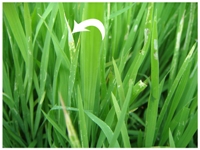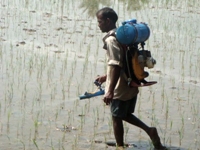|
Thrips
| |||||||||||||||||||||||||||||||||||||||||||||||||||||||||||||||||||||
| Symptom of Damage : | ||
Nature of Damage : Both the adults and nymphs lacerate the tender leaves and suck up the plant sap. As a result fine yellowish lines or silvery streaks are seen on the leaves. Later, the leaves curl longitudinally and begin to dry from the tip downwards In severe cases, the entire nursery may dry up and fail to produce seedling. Sometimes transplanted crop is also affected in the early stages. |
 |
 |
| Laceration of tender leaves | Silvery streaks on the leaves | |
 |
 |
|
| Infected leaves roll inwards along the margins | Terminal rolling and drying of leaves | |
| Top | ||
| Identification of pest : | ||
Scientific Name - Stenchaetothrips biformis
|
 Nymph Nymph |
 Winged Nymph Winged Nymph |
 Adult |
 Adult Adult |
|
| Top | ||
| Management Strategies : | ||
Cultural Methods:
|
 |
 |
| Flood the infected nursery | Submerge infected field | |
Chemical Methods:
|
 |
|
| Spray Phosphomidan | ||
 |
||
| Spraying of pesticide | ||
Biological Methods:
|
 |
 |
| Anthocorid bug | Coccinellid beetles | |
 |
 |
|
| predatory thrips | staphylinid beetles | |
| Top | ||
